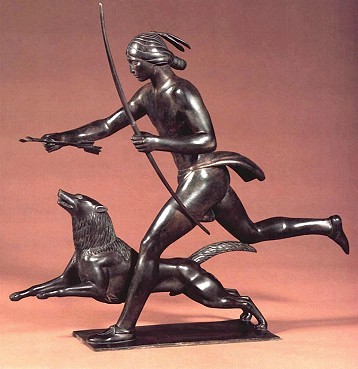| |
|
|
Areas
where Pre-Columbian
‘American Indian Dogs’
were Found
|
These map pages were created to help people that
are interested in knowing where the original American Indian Dogs came
from, and what they looked like. They also show where our foundation dogs
in the American Indian Dog breeding program originated. You will see how
the Plains Indian Dogs are the combination of all the types (breeds) from
all "Four Directions", around the centrally located Plains Indian
Dog breeders, and that there are only small size and personality differences
(variables) between them. Notice, also, the similarities of the Old Dogs
to the modern American Indian Dog breed of today. We keep some of the
original, slight differences (variables) as pure as possible within those
type bloodlines, and use these as an outcross mix, to maintain the perfectly
balanced combination, variable mix, or recipe that the Plains Indians
practiced hundreds and thousands of years ago. If you know what you are
looking for, there are many ways to tell a real Indian Dog that is descended
from the "Old Dogs", from any modern breed; one example is,
that they are double jointed and were bred that way to be able to get
into small spaces, holes in the ground, or caves, when hunting. As many
owners will attest, they spread their back legs out behind them and can
crawl around like this or sleep this way, which is proof of their healthy
joints and dexterity, as well as the breeding abilities of the Native
Americans and the value of their "Old Ways" of natural, logical
breeding. This breed has not changed in the last 500 years and you can
see this from a comparison of the present blood lines to their ancient
Pre-Columbian descendants. (for more information on ‘Foundation History’,
please read the foundation history page here). According to the Elders,
early explorers, researchers, and where some modern dogs are still found,
these are the area’s that all the old working dogs had come from
in Pre-Columbian times. Of course some of these areas over lapped, and
some types from one area were traded and dispersed (in small numbers)
to another. Then they, in turn, were bred to the common type of that area,
and the pups from those breeding's, were traded back to the Plains breeders.
|
|
|
Click
area colors to see pictures and descriptions of the
American Indian Dog ancestors and modern comparisons
|
These
are the basic geographical areas where the working dogs were found. Note
the small area around San Francisco Bay where there has been no archeological
evidence of the Old Dogs. No one knows why, and there are theories, but
no clear answers as of yet. Three other types of dogs - the small hairless,
the pug nosed and the wool dogs - were not used hundreds and thousands
of years ago within the working dog breeds, and we did not use any of
those breeds in our foundation lines or the current lines. So these types
are not included on this map of "The Historical Geography of the
American Indian Dog”. We hope this will help people to understand
where the old dogs came from, and what they looked like--then and now.
They were not wolf hybrids; they were never larger than 55lbs and they
only came in the agouti ticked (SABLE) color and markings, never brindle
or spotted as these are modern breed color factors. Perhaps with education
and controlled, balanced, variable breeding practices, according to "The
Old Ways", our primitive American Indian Dog breed can stay healthy
and wise for future generations to enjoy.

Click
on the respective colors and names that represent the types listed on
the legend, to see pictures and descriptions of the various old and new
bloodlines, and compare the perspective area types.
© (By Kim La Flamme, founder/trustee of the American Indian Dog breed
- please attain permission “for the educational use” of any
or all of this article.
|